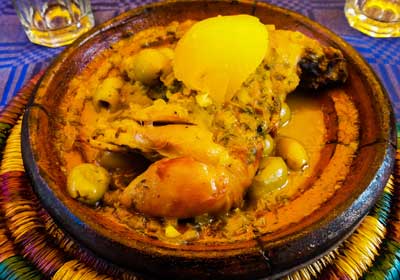


The traditional cuisine of Morocco has been enhanced by the Berber clans of the mountains with their couscous and tajines, the Arabs from Persia who touched base in the seventh century bringing flavors, the Moors on their arrival from Andalucia after the Christians pushed them out bringing olive oil and citrus natural products, and all the more as of late, the French.
An amazing 22% of the land in Morocco is cultivated (astonishing considering the mountains and desert present), growing olives, almonds, citrus, grapes, dates, beats, vegetables, sugar beet, sugar stick, cotton and oilseeds.
Meats produced are predominantly lamb and chicken, while the long Mediterranean and Atlantic coast lines produce a variety of fish. You are far-fetched obviously to discover pork here!
Despite the fact that vegetables are generally accessible, vegan suppers may be hard to discover, especially far from the visitor zone.
The nation is just about independent in food production with seasonal climate varieties causing deficiencies in certain years.
Couscous
Produced using semolina (coarsely ground hard wheat with the grain expelled) and is an essential Berber sustenance and is presented with meat, vegetables, and potentially nuts and organic product. The conventional technique for making couscous is an extensive procedure and sometimes, cafés may expect it to be requested ahead of time.
Tajines
Another arrangement of old Berber dishes, moderate cooked in a shallow pottery pot of a similar name having a funnel shaped top, frequently made with sheep or chicken in addition to vegetables. Tajines are gently spiced with saffron, cumin and coriander giving an unmistakable flavor.
Pastilla
Chicken or Pigeon in a rich lemon souce, layered between fine layers of cake
Bread
A significant piece of any Moroccan dinner, this will be a level bread which is broken and use as an instrument to help gobbling and to douse up sauce.
Harira
This is a thick stock or soup containing sheep or chicken, lentils, chickpeas, tomatoes onions and herbs. Harira is generally eaten at night during Ramadan, to break the quick.
Mint Tea
In spite of the fact that not presented until the nineteenth century, tea is the national beverage, taken at different occasions of the day and after suppers, dependably enhanced with mint, and normally improved with a lot of sugar.
The tea is customarily made in elaborate metal tea kettles and served in a glasses, poured from a tallness to make it foamy.
Food and Drink for the Tourist
Morocco welcomes visitors and in the vacationer zones you will discover an assortment of universal sustenance and drink accessible in the more current traveler regions.
Copyright tizi trekking 2019